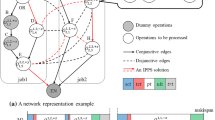Abstract
An innovative approach based on the two-stage ant colony optimization (ACO) approach is used to optimize the process plan with the objective of minimizing total production costs (TPC) against process constraints. First, the process planning (PP) problem is represented as a directed graph that consists of nodes, directed/undirected arcs, and OR relations. The ant colony finds the shortest path on the graph to achieve the optimal solution. Second, a two-stage ACO approach is introduced to deal with the PP problem based on the graph. In the first stage, the ant colony is guided by pheromones and heuristic information of the nodes on the graph, which will be reduced to a simple weighed graph consisting of the favorable nodes and the directed/undirected arcs linking those nodes. In the second stage, the ant colony is guided by heuristic information of nodes and pheromones of arcs on the simple graph to achieve the optimal solution. Third, the simulation experiments for two parts are conducted to illustrate the application of the two-stage ACO approach to the PP problem. The compared results with the results of other algorithms verify the feasibility and competitiveness of the proposed approach.
Similar content being viewed by others
References
Li WD, Ong SK, Nee AYC (2002) Hybrid genetic algorithm and simulated annealing approach for the optimization of process plans for prismatic parts. Int J Prod Res 40(8):1899–1922
Zhang F, Zhang YF, Nee AYC (1997) Using genetic algorithms in process planning for job shop machining. IEEE Trans Evol Comput 1(4):278–289
Li WD, Ong SK, Nee AYC (2004) Optimization of process plans using a constraint-based tabu search approach. Int J Prod Res 42(10):1955–1985
Prabhu P, Elhence S, Wang H (1990) An operations network generator for computer aided process planning. J Manuf Syst 9:283–291
Lin AC, Lin SY, Diganta D, Lu WF (1998) An integrated approach to determining the sequence of machining operations for prismatic parts with interacting features. J Mater Process Technol 73:234–250
Huang WJ, Hu YJ, Cai LG (2012) An effective hybrid graph and genetic algorithm approach to process planning optimization for prismatic parts. Int J Adv Manuf Technol 62:1219–1232
Dorigo M, Maniezzo V, Colorni A (1996) The ant system: optimization by a colony of cooperating agents. IEEE Trans Syst Man Cybern B Cybern 26(1):29–41
Montemanni R, Gambardella LM, Rizzoli AE, Donati AV (2005) Ant colony system for a dynamic vehicle routing problem. J Comb Optim 10:327–343
Hamzheei M, Farahani RZ, Rashidi-Bajgan H (2013) An ant colony-based algorithm for finding the shortest bidirectional path for automated guided vehicles in a block layout. Int J Adv Manuf Technol 64:399–409
Ghaiebi H, Solimanpur M (2007) An ant algorithm for optimization of hole-making operations. Comput Ind Eng 52:308–319
Liu XJ, Hong Y, Ni ZH, Qi JC, Qiu XL (2013) Process planning optimization of hole-making operations using ant colony algorithm. Int J Adv Manuf Technol 69:753–769
Zheng QX, Li M, Li YX, Tang QH (2013) Station ant colony optimization for the type 2 assembly line balancing problem. Int J Adv Manuf Technol 66:1859–1870
Yu JP, Wang CG (2013) A max-min ant colony system for assembly sequence planning. Int J Adv Manuf Technol 67:2819–2835
Prakash A, Tiwari MK, Shankar R (2008) Optimal job sequence determination and operation machine allocation in flexible manufacturing systems: an approach using adaptive hierarchical ant colony algorithm. J Intell Manuf 19:161–173
Korytkowski P, Rymaszewski S, Wisniewski T (2013) Ant colony optimization for job shop scheduling using multi-attribute dispatching rules. Int J Adv Manuf Technol 67:231–241
Krishna AG, Mallikarjuna Rao K (2006) Optimisation of operations sequence in CAPP using an ant colony algorithm. Int J Adv Manuf Technol 29:159–164
Liu XJ, Yi H, Ni ZH (2013) Application of ant colony optimization algorithm in process planning optimization. J Intell Manuf 24:1–13
Zhang WB, Lu ZH, Zhu GY (2006) Optimization of process route by genetic algorithms. Robot Comput Integr Manuf 22:180–188
Lian KL, Zhang CY, Shao XY, Zeng YH (2011) A multi dimensional tabu search for the optimization of process planning. Sci China Technol Sci 54(12):3211–3219
Ma GH, Zhang YF, Nee AYC (2000) A simulated annealing-based optimization for process planning. Int J Prod Res 38(12):2671–2687
Guo YW, Mileham AR, Owen GW, Li WD (2006) Operation sequencing optimization using a particle swarm optimization approach. Proc IMechE B J Eng Manuf 220:1945–1958
Li XY, Gao L, Wen XY (2013) Application of an efficient modified particle swarm optimization algorithm for process planning. Int J Adv Manuf Technol 67:1355–1369
Stefan S, Luc B, Lieva VL (1996) Optimising a production process by a neural network/genetic algorithm approach. Eng Appl Artif Intell 9:681–689
Chan FTS, Swarnkar R, Tiwari MK (2005) Fuzzy goal programming model with an artificial immune system (AIS) approach for a machine tool selection and operation allocation problem in a flexible manufacturing system. Int J Prod Res 43(5):4147–4163
Xu X, Wang LH, Newman ST (2011) Computer-aided process planning—a critical review of recent developments and future trends. Int J Comput Integr Manuf 24(1):1–31
Yusof Y, Latif K (2014) Survey on computer-aided process planning. Int J Adv Manuf Technol 75:77–89
Author information
Authors and Affiliations
Corresponding author
Rights and permissions
About this article
Cite this article
Wang, J., Wu, X. & Fan, X. A two-stage ant colony optimization approach based on a directed graph for process planning. Int J Adv Manuf Technol 80, 839–850 (2015). https://doi.org/10.1007/s00170-015-7065-7
Received:
Accepted:
Published:
Issue Date:
DOI: https://doi.org/10.1007/s00170-015-7065-7




